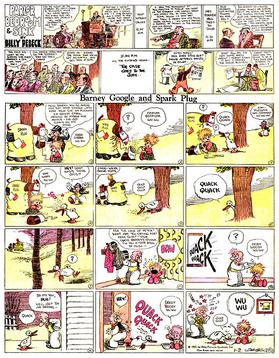Related Research Articles
A comic strip is a sequence of cartoons, arranged in interrelated panels to display brief humor or form a narrative, often serialized, with text in balloons and captions. Traditionally, throughout the 20th and into the 21st century, these have been published in newspapers and magazines, with daily horizontal strips printed in black-and-white in newspapers, while Sunday papers offered longer sequences in special color comics sections. With the advent of the internet, online comic strips began to appear as webcomics.

The Yellow Kid is an American comic-strip character that appeared from 1895 to 1898 in Joseph Pulitzer's New York World, and later William Randolph Hearst's New York Journal. Created and drawn by Richard F. Outcault in the comic strip Hogan's Alley, it was one of the first Sunday supplement comic strips in an American newspaper, although its graphical layout had already been thoroughly established in political and other, purely-for-entertainment cartoons. Outcault's use of word balloons in The Yellow Kid influenced the basic appearance and use of balloons in subsequent newspaper comic strips and comic books.

Stephan Thomas Pastis is an American cartoonist and former lawyer who is the creator of the comic strip Pearls Before Swine. He also writes children's chapter books, commencing with the release of Timmy Failure: Mistakes Were Made. The seventh book, It's the End When I Say It's the End, debuted at #4 on The New York Times Best Seller list for Children's Middle Grade Books.

A topper in comic strip parlance is a small secondary strip seen along with a larger Sunday strip. In the 1920s and 1930s, leading cartoonists were given full pages in the Sunday comics sections, allowing them to add smaller strips and single-panel cartoons to their page.

The Newspaper Enterprise Association (NEA) is an editorial column and comic strip newspaper syndication service based in the United States and established in 1902. The oldest syndicate still in operation, the NEA was originally a secondary news service to the Scripps Howard News Service; it later evolved into a general syndicate best known for syndicating the comic strips Alley Oop, Our Boarding House, Freckles and His Friends, The Born Loser, Frank and Ernest, and Captain Easy / Wash Tubbs; in addition to an annual Christmas comic strip. Along with United Feature Syndicate, the NEA was part of United Media from 1978 to 2011, and is now a division of Andrews McMeel Syndication. The NEA once selected college All-America teams, and presented awards in professional football and professional [NBA] basketball.
Jimmy Johnson is an American comic strip cartoonist who writes and draws Arlo and Janis.

The Sunday comics or Sunday strip is the comic strip section carried in most Western newspapers. Compared to weekday comics, Sunday comics tend to be full pages and are in color. Many newspaper readers called this section the Sunday funnies, the funny papers or simply the funnies.
Universal Press Syndicate (UPS), a subsidiary of Andrews McMeel Universal, was an independent press syndicate. It distributed lifestyle and opinion columns, comic strips and other content. Popular columns include Dear Abby, Ann Coulter, Roger Ebert and News of the Weird. Founded in 1970, it was merged in July 2009 with Uclick to form Universal Uclick.

Julian W. Blake was an American cartoonist who created the popular, long-running comic strip Tiger, about a group of suburban boyhood pals. Distributed by King Features Syndicate, Tiger began May 3, 1965. At its peak, it was published internationally in some 400 newspapers.
Broom-Hilda is an American newspaper comic strip created by cartoonist Russell Myers. Distributed by Tribune Content Agency, it depicts the misadventures of a man-crazy, cigar-smoking, beer-guzzling, 1,500-year-old witch and her motley crew of friends.

Richard Church Thompson was an American illustrator and cartoonist best known for his syndicated comic strip Cul de Sac and the illustrated poem "Make the Pie Higher". He was given the Reuben Award for Outstanding Cartoonist of the Year for 2010.
William Miles Perry was an American cartoonist, known as an assistant on, and later a primary artist for, the Gasoline Alley comic strip.

The Billy Ireland Cartoon Library & Museum is a research library of American cartoons and comic art affiliated with the Ohio State University library system in Columbus, Ohio. Formerly known as the Cartoon Research Library and the Cartoon Library & Museum, it holds the world's largest and most comprehensive academic research facility documenting and displaying original and printed comic strips, editorial cartoons, and cartoon art. The museum is named after the Ohio cartoonist Billy Ireland.
Allan Holtz is an American comic strip historian who researches and writes about newspaper comics for his Stripper's Guide blog, launched in 2005. His research encompasses some 7,000 American comic strips and newspaper panels. In addition to his contributions to Hogan's Alley and other publications about vintage comic strips, he is the author of American Newspaper Comics: An Encyclopedic Reference Guide (2012). He is a resident of Tavares, Florida.

Hogan's Alley is a magazine devoted to comic art, published on an irregular schedule since 1994 by Bull Moose Publishing in Atlanta, Georgia, United States. Subtitled "the magazine of the cartoon arts", it covers comic strips, comic books, cartoons, and animation. Originally planned as a quarterly, the frequency is closer to that of an annual, with 20 issues published in 22 years.
Richard "Rick" Marschall is an American writer, editor, and comic strip historian, described by Bostonia magazine as "America's foremost authority on pop culture." Marschall has served as an editor for both Marvel and Disney comics, plus several syndicates.

Andrews McMeel Syndication is an American content syndicate which provides syndication in print, online and on mobile devices for a number of lifestyle and opinion columns, comic strips and cartoons and various other content. Some of its best-known products include Dear Abby, Doonesbury, Ziggy, Garfield, Ann Coulter, Richard Roeper and News of the Weird. A subsidiary of Andrews McMeel Universal, it is headquartered in Kansas City, Missouri. It was formed in 2009 and renamed in January 2017.
Oh, Brother! is an American comic strip by Bob Weber Jr. and Jay Stephens, launched June 28, 2010, by King Features Syndicate. On July 29, 2011, the Oh, Brother! team announced the finale on their blog. Daily syndication ceased on August 7, 2011.
Quincy is an American syndicated newspaper comic strip published from July 13, 1970 to October 4, 1986, created and produced by cartoonist Ted Shearer. The series, about an African-American boy being raised by his grandmother in Harlem, was one of the earliest mainstream comic strips to star an African American in the lead role, following Dateline: Danger! (1968-1974) and Luther (1969-1986). Another predecessor, Wee Pals, features an African-American among an ensemble cast of different races and ethnicities.
The New York World was one of the first newspapers to publish comic strips, starting around 1890, and contributed greatly to the development of the American comic strip. Notable strips that originated with the World included Richard F. Outcault's Hogan's Alley, Rudolph Dirks' The Captain and the Kids, Denys Wortman's Everyday Movies, Fritzi Ritz, Gus Mager's Hawkshaw the Detective, Victor Forsythe's Joe Jinks, and Robert Moore Brinkerhoff's Little Mary Mixup.
References
- ↑ Holtz, Allan (2012). American Newspaper Comics: An Encyclopedic Reference Guide. Ann Arbor: The University of Michigan Press. p. 386. ISBN 9780472117567.
- ↑ Tiger at Don Markstein's Toonopedia. Archived from the original on June 9, 2015.
- ↑ ""Blake Superior: The Bud Blake Interview," Hogan's Alley #13, 2003". Archived from the original on 2013-03-12. Retrieved 2012-12-13.
- ↑ "The Star-Ledger. "Nutley's Bud Blake, drew Tiger comic", December 30, 2005". Archived from the original on December 24, 2006. Retrieved January 3, 2006.